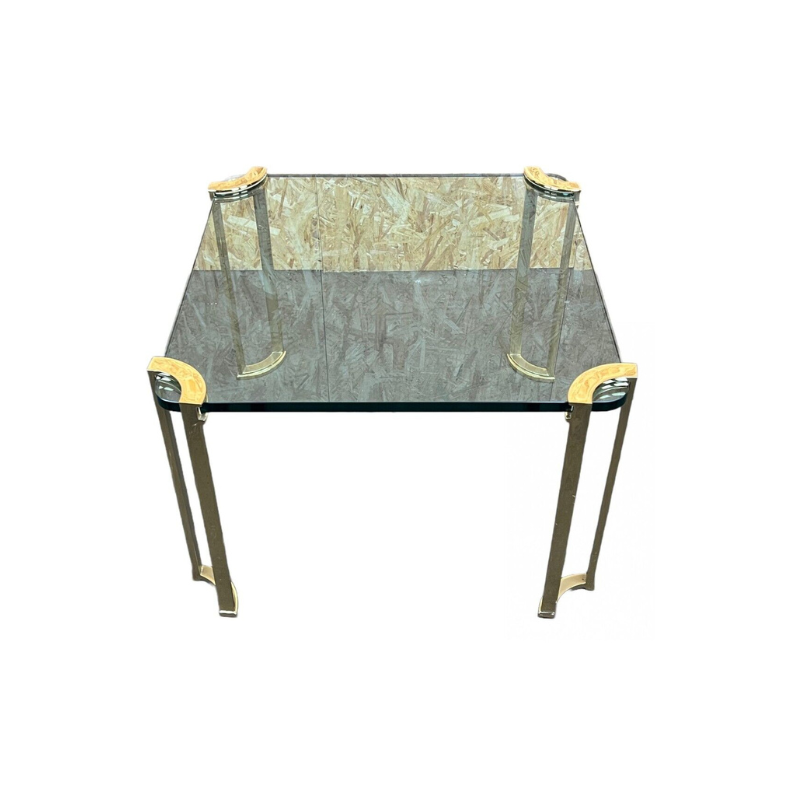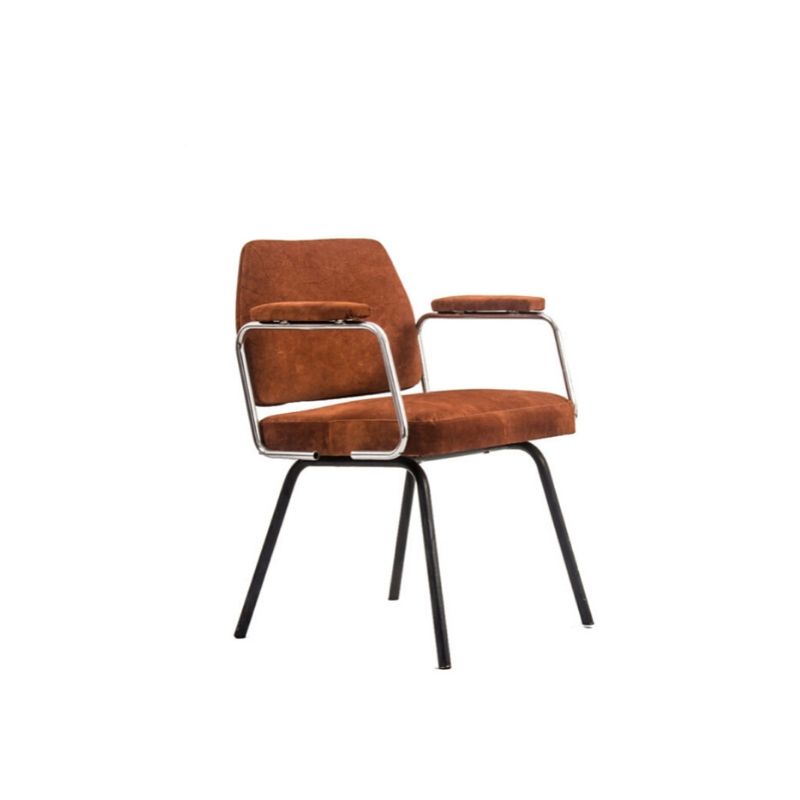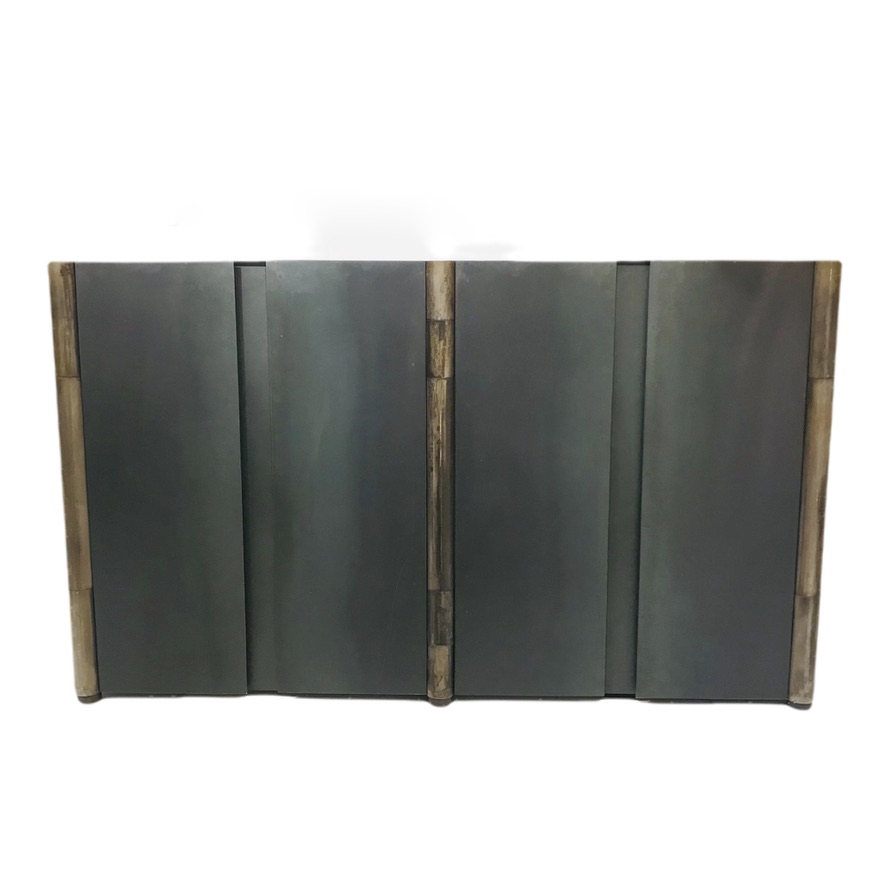jesgord,
Yes, my HAAN steamer is just like that one, although it might be the prior model of it. When the jet of steam hits the cane it becomes very limber -- quite a lot more so than just from soaking, And, if you have been working with a long piece of cane for a while, it cane start to dry out and stiffen somewhat when you are working with it. The steamer makes it easy to get around tight bends without the cane breaking any fibers, but it also makes it conform to the contours of things very well.
Probably the tightest bend on this chair is where the cane strands are folded where they go into holes at the bottom of the backrest (the chair is turned upside down for this image). If you use the steamer, the cane just melts like butter. Sometimes, without the steam it feels like you are stressing or even breaking some of the fibers in the cane when you bend it over at an angle like that.
Also, when you are overlapping edges of the cane, which I now see is an integral part of working with the stuff, the steamer makes the cane soft enough that it does not want to slip off the piece you overwrapped it onto. It also makes it a bit stretchy. It is a very useful thing to have, although technically it is sold as a cleaning tool. I also use it to loosen glue joints.
Also, in the image below you can possibly see how the cane strands overlap each other here on the bottom of the backrest. At the top of the backrest they do not overlap. You could actually vary the amount of overlap quite a lot, if you had to.
Starting work on chair #2. Fortunately, Johannes Hansen and Co. used pretty close tolerances, as this chair is made from parts of two chairs. The two back legs and the front stretcher are from a broken chair I got from cdsilva. Before I glue it together I need to strip the finishes that were applied to the parts over the years. Someone put a walnut finish on cdsilva's chair, and the other chair I used parts from has some kind of red finish on it that might actually have been intended to make the chair look like it was made of cherry. All the chair parts are made of teak however.
I am surprised how well the parts from two different chairs were so interchangeable, as a lot of hand shaping work went into these chairs in the early 50's, especially where the backrest/arms meets the top of the legs.
I'm not sure when the company first used automated machining of the parts of this chair -- Koen may still have access to a wonderful video showing some steps of the manufature -- but the aim always, as with an automobile or other complex object, is to have the parts all alike, so that all parts fit well without modification, even if made on different days at different facilities or departments. A handy side effect is that parts are interchangeable. The points of connection, and their diameters, etc, would thus be closely controlled. I'm sure this was the case even before computer-controlled milling was introduced. The assembly video showed (as I recall it) fully shaped arms being attached to the assembled leg structure. In the case of this chair, there is a slight reveal -- both halves of the joint being slightly rounded -- where the arm meets the front leg. This is, in effect, a "tell" that the parts were fully shaped prior to assembly -- something that an up-to-date maker would be proud of, I think.
Koen, if you're with us, could you provide a link to that video -- if it's still out there online, somewhere ?
SDR
A problem that my second chair had that I knew I was going to have to deal with is that a dowel peg tip on one of the legs had been broken off at some point. As SDR had noted (and is shown in the video above) this dowel tip is turned on the lathe as a part of the leg itself. To fix it I knew I would have to make a jig to drill a hole straight down into the leg about 1 inch so that a new dowel could be inserted. I know better than to consider trying to drill something like this freehand, so I knew I would have to make a jig in order to keep the drill bit aligned.
I ended up using PVC pipe, PVC pipe fittings, and a length of brass tubing that had an inside diameter of exactly 1/2", which is the size of the dowel/drill bit used. To make all of the pipes fit together, telescope style, I wrapped them with masking tape to create bushings that would allow the pieces to fit snuggly in an aligned position. I also had to create a bushing for the top of the leg itself, due to the way the leg tapers, so that it would fit inside the largest PVC pipe in more or less perfect alignment.
Nice work. Good results are no accident; taking the trouble to anticipate problems and address them with appropriate fixturing is essential. Your job was perhaps made a bit easier by the fact that you were drilling into virgin material, and not into a previously placed dowel ?
I assume you will chamfer the end of your new dowel, the better to spread glue over the mating surfaces . . .
SDR, I don't really ever try to drill out a full size dowel remnant all at once. I always drill a series of smaller holes, each getting larger, until I am finally able to peel the remaining parts of the dowel from hole itself. Had there been a dowel remnant, I would have removed it, and then used the original hole for a new dowel.
In this case my concern was that if I used a drill bit that aggressively pulled itself into the end grain wood I was making the hole in, as a standard twist drill bit sometimes can do, it might blow out the side of the leg, which I definately did not want.
So, I used a very sharp, brand new spur point dowelling bit that would do a slow cut, and also a good job of removing the wood chips so that the bit would not bind on them. In any case, I backed the bit out numerous times to clear the hole of chips before I got the depth I wanted.
Sounds good. New drills and router cutters (bits) are a treat, which the craftsman deserves whenever possible !
The only time I've had any drill "pull," or drill faster than I intended, was when reaming out a hole smaller than the bit I was using. The last step of the excellent dowel-removing procedure you outlined would be one such instance, in my experience. In any event, I'm glad you didn't have to do that this time . . .
I worry a bit about the socket that Wegner provided on the bottom of his arm, to receive and align with the leg -- because parts of that raised socket are potentially weak short-grain. I guess there's enough meat there to take whatever stresses might occur during breakage or disassembly ?
SDR, the broken chair I got from cdsilva had experienced a mishap at some point that broke the arm joints as you described. I think the potential for this is inherent to this arm design. On the second hand market I see repairs quite often for breaks like this to all kinds of Danish chairs.
This Kofod Larsen chair is even more delicate. Generally, I think that the Wegner chair is pretty tough. It could break if it were abused or dropped, or it one continued to use it with loose glue joints that put stress on the components, but I am not very worried that my chairs would just up and break at any point.
If you need any help, please contact us at – info@designaddict.com









